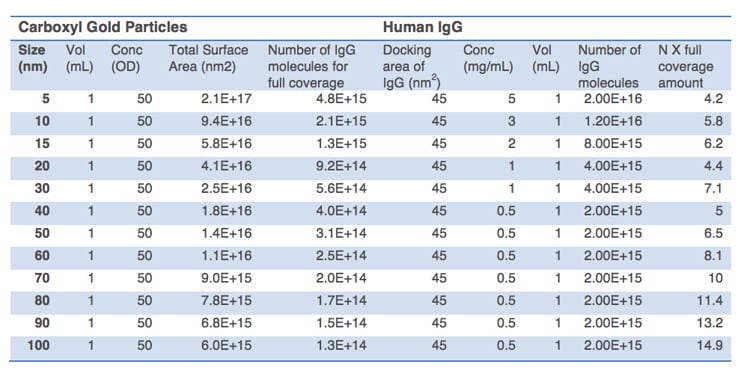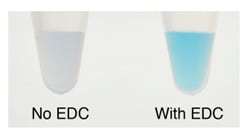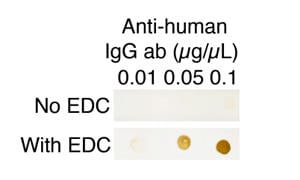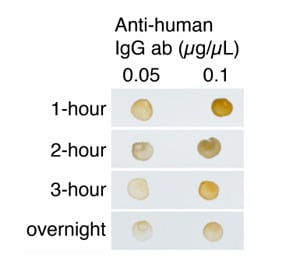Covalent Conjugation of Proteins to Carboxylated Gold Nanoparticles
Background
Gold nanoparticle conjugates have been widely used in biological research and biosensing applications. For example, gold nanoparticles can function as probes in light or electron microscopy, lateral flow immunoassays and immunoblotting protocols such as dot-blots and Western blots.
There are two ways of preparing gold conjugates, i.e. passive absorption and covalent coupling via a linker. Although a relatively simple preparation process, passive absorption of proteins to gold nanoparticles does not provide a permanent attachment of the coating because molecules may desorb from the surface over time. In addition, in some cases, the proteins lose their properties after being absorbed to the surface, which can be caused by changes in tertiary structure or binding of the active site/antigen binding site to the gold surface rendering it inaccessible.
Despite these drawbacks passive adsorption of proteins to gold nanoparticles remains popular and is a simple way of generating a protein gold conjugate. Preparation of gold nanoparticle protein conjugates through passive adsorption to standard spherical gold nanoparticles can be optimized with our convenient Gold Conjugation Optimization Kits for Passive Adsorption.
In comparison to passive adsorption, covalent coupling permanently immobilizes molecules of interest to functionalized gold nanoparticles (e.g. with NHS, carboxyl or amine groups). This approach provides much improved stability of the protein coating over the passive absorption method. Covalent coupling uses chemical linkers that react with specific chemical groups on the molecule to be conjugated. Therefore, the method is more specific and controllable than the passive absorption method and the number of covalently conjugated ligands can be optimized for a particular application. Covalent coupling through a linker also have the advantage of minimizing steric hindrance and impact on the tertiary structure of the conjugated protein. All in all this results in less deleterious effects on the properties of a conjugated protein.
Our Carboxyl Gold Nanoparticles, Carboxyl Gold NanoUrchins and Carboxyl Gold Nanorods all rely on EDC/NHS chemistry for conjugation. EDC and NHS “activate” the carboxyl groups on the particle surface to form an intermediate that can subsequently react with primary amine groups on the specific protein or other ligand to be conjugated. The efficiency of EDC conjugation is typically low and sensitive to pH and covalent coupling protocols requires some degree of optimization to achieve desired performance or stability.
The following protocol provides general guidelines for coupling biomolecules to our carboxylated gold ganoparticles, with conjugation of a standard IgG to our 20nm Carboxyl Gold Nanoparticles given as an example. For conjugation of other biomolecules or nanoparticle types, the optimal conjugation conditions may vary. To obtain maximum conjugation to the particle surface, the amount of protein for conjugation is about 1 to 10X excess that of its theoretical quantity needed for full coverage.
Materials and Equipment Required
- 20nm Carboxyl Gold Nanoparticles
- Methyl Gold Nanoparticles (negative control)
- 1-Ethyl-3-[3-dimethylaminopropyl]carbodiimide hydrochloride (EDC) (Sigma, Cat# E1769)
- N-hydroxysulfosuccinimide (Sulfo-NHS) (Sigma, Cat# 56485)
- Positive control protein: Horse Radish Peroxidase (HRP) or IgG from human serum (Sigma, Cat# I4506)
- Blocker: Bovine Serum Albumin (BSA) (Sigma, Cat# A3059)
- Activation buffer: 2-(N-morpholino)ethanesulfonic acid (MES) buffer (10 mM, pH 5.5)
- Coupling buffer: 1X Phosphate Buffered Saline (PBS)
- Washing buffer: 1X Phosphate Buffered Saline + 0.05% Tween 20 (PBST)
- UV-VIS Spectrophotometer
- Protein of interest to be conjugated
Note: It is imperative that the protein to be conjugated is pure and free of contaminating proteins (e.g. BSA) and other amine containing components. Any other molecules containing primary amines may compete with the protein to be conjugated and may result in a significant decrease in conjugation efficiency. The protein should also have enough accessible primary amine groups for conjugation. Lysine residues are the primary target sites for EDC conjugation.
Procedure
- If the concentration of gold nanoparticles is less than OD 50, concentrate them by centrifugation. If particles are in buffers, wash them in pure water by centrifugation. Refer to “Gold Nanoparticles Handling and Storage” for instructions.
-
Prepare fresh EDC/NHS mix solution in MES buffer at a concentration of 30 and 36 mg/mL, respectively. Note that EDC/NHS rapidly hydrolyzes in aqueous solutions and should be prepared fresh just prior to conjugation.
- Take 10 µL of 20 nm gold nanoparticles (OD 50 in water) and mix with 10 µL of EDC/NHS mix solution as prepared in step 2.
- Incubate for 30 min at room temperature
- Add 1 mL of PBST and vortex thoroughly
- Spin down by centrifugation at 6,500 g for 30 min
- Remove most of the supernatant
- Add 10 µL of IgG (1 mg/mL in 1X PBS)*
- Sonicate in a water bath sonicator for 10 sec
- Incubate for 2 to 4 hours at room temperature with mixing
- Add 1 mL of PBST and vortex thoroughly
- Spin down by centrifugation at 3,500 g for 30 min
- Remove most of the supernatant
- Add 50 µL PBS with 1% BSA
- Store at 4 degrees and ready to use
* The concentration of protein may vary depending on the particle size and protein to be conjugated. In general, the amount of protein should be 1 to 10X excess of the amount of full surface coverage. The total surface area of particles and the docking area should be estimated to calculate the optimal amount of protein. The following table is a general reference for conjugating IgG to our Carboxyl Gold Particles of different sizes. The calculation for other proteins are similar but the docking area needs to be calculated for your protein of interest.
Table I. Suggested quantities of IgG for Carboxyl Gold Nanoparticles of different sizes during EDC conjugation. The docking area of an IgG molecule is estimated to be 45 nm2. “N X full coverage amount” means the excess ratio between the incubation amount and the amount needed for full coverage of particle surface.

Validation of Successful Conjugation
In many cases there is no direct measurement to validate successful conjugation and the best approach is therefore to subject the conjugated particles to a functional test. This can either be a direct test in the assay or application of interest or alternatively if an antibody has been conjugated, functionality can be validated with an immuno-dot blot assay. We also recommend to always include a separate positive control when performing EDC/NHS conjugations and two examples are given below.
HRP-TMB Assay
This assay uses HRP as a positive control for EDC conjugation, and TMB assay for signal readout. It is a simple, fast and sensitive method. Briefly, after conjugation, mix 5 µL of conjugated particles with 100 µL of TMB solution and develop for 1 to 2 minutes. The solution turns blue if there is successful conjugation of HRP.

Figure 1. TMB assay on HRP-conjugated gold nanoparticles. Particles are treated with or without EDC and then incubated with HRP for conjugation. Particles are then incubated with TMB. The solution containing HRP-conjugated gold nanoparticles (right) turns blue, indicating successful conjugation.
Immuno-Dot Blot Assay
This assay uses IgG as a positive control for EDC conjugation, and a dot-blot assay for signal read out. This assay may be a better control for confirmation of IgG functionality after conjugation onto particles.
Materials Required
- Goat anti-human IgG(H+L) antibody
- Membrane Blocking Solution: 5% (w/v) dry milk
- Silver Enhancer Kit for Membranes (Cytodiagnostics Cat# SR-01-02)
- Nitrocellulose Membrane (Whatman, Cat# 10 402 594C)
- Optional: Mini Incubation Trays (Bio-Rad, Cat#170-3902)
Procedure
- Prepare a serial dilution of Goat anti-human IgG(H+L) antibody in 1X PBS: 0.01, 0.05, and 0.1 µg/µL.
- Spot 1 µL of the above solutions onto a nitrocellulose membrane strip and air-dry for 15 minutes.
- Transfer the membrane strips to a Mini Incubation Tray or a regular glass/plastic 2-mL vial.
- Add 1 mL of the Membrane Blocking Solution (make sure the solution covers the whole membrane).
- Put the tray or vials on a rocking plate and incubate for 30 minutes at room temperature.
- Add calculated amount of human IgG-conjugated particles to reach the final concentration of OD 0.5.
- Continue incubation for 2 hours on a rocking platform at room temperature.
- Remove the solution.
- Add 1 mL of water containing 0.05% Tween 20 to wash the membrane.
- Remove the water and repeat washing step twice.
- Add 1 mL of silver enhancing reagents (prepare freshly before use according to instructions in kit).
- Develop for 15 minutes and observe colour change.

Figure 2. Dot-blot assay of Goat anti-human IgG antibody using human IgG-conjugated gold particles. Particles are treated with or without EDC and then incubated with human IgG for conjugation. There is concentration-dependent positive signal only when the particles are treated with EDC (lower row), suggesting successful conjugation.
Frequently Asked Questions
Q: what is the optimal conjugation pH for conjugation?
A: Activation of the carboxylated gold nanoparticles using EDC/NHS is generally performed in slightly acidic conditions while the conjugation reaction is optimally performed around pH 7-8.
Q: what is the optional conjugation time?
A: In our standard protocol, we conjugate 2 to 4 hours at room temperature for proteins. Based on the stability of proteins, a shorter or longer conjugation time should be tested. The conjugation efficiency of EDC is usually low, so a 2 hour incubation are often seen in many protocols. A shorter than 2-hour conjugation period may be enough, depending on the applications and protein concentrations. It is necessary to carry out a kinetic study on conjugation time versus final result output for different proteins or molecules to be conjugated. For example, we conjugated human IgG to our Carboxyl Gold Nanoparticles for 1 hour, 2 hours, 3 hours and overnight. 2 hours of conjugation time demonstrate the best dot-blot assay performance:

Figure 3. Effect of conjugation time on the performance of dot-blot assay. Particles are incubated with human IgG for 1 hour, 2 hours, 3 hours and overnight. 2 hours of incubation shows the best dot-bot signal among all conjugation times.
Q: what are the pros and cons of 1-step conjugation?
A: The advantage of 1-step conjugation is its simple procedure. However, 1-step conjugation comes with a risk of crosslinking proteins among themselves, instead of conjugating them onto the particles. This risk is dependent on the structure of the protein to be conjugated, which determines the ratio of the accessible carboxyl groups between the proteins and particles. Also, excess amounts of EDC/NHS will increase the chance of protein crosslinking. It is recommended to carry out titration experiments of protein and EDC/NHS concentrations to find the conditions of maximal conjugation/performance with minimal protein crosslinking.
Q: what other factors can influence conjugation results?
A: if the conjugation pH and conjugation time are suitable, but there is no positive result, it is necessary to make sure EDC/NHS is freshly prepared just before conjugation. EDC should always be stored at -20 degrees. Effective removal of excess EDC/NHS after activation is important to prevent them from crosslinking proteins.